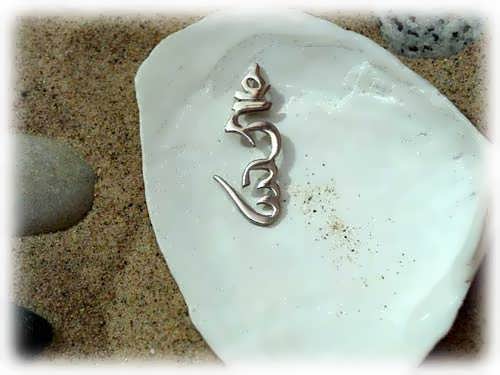The Tibetan Hung symbol is probably the most popular of the various Tibetan symbols. It was taken from the ancient Tibetan prayer or mantra, ‘Om Mani Padme Hum’ or ‘Om Mani Padme Hung.’ Translated, this means ‘Hail to the Jewel in the Lotus.’ It is believed that everything essential that Buddha taught is contained in this mantra, which is indicative of the path to transform one’s impure mind and body into the pure, exalted speech and mind of Buddha through detachment. Needless to say, it is a quite powerful mantra and symbol, which can purify body, speech, and mind.
When used in meditation or if recited daily, Om Mani Padme Hum (or Hung) can remove negative karma and thoughts and help one achieve enlightenment and awareness. The last word, ‘Hum’ or ‘Hung’ means indivisibility or something which cannot be torn apart. It holds both wisdom and method and this cannot be broken or divided. It is a reminder that each one of us has purity within us—we just have to go through the paths to enlightenment to uncover it and erase all impurities from ourselves. The symbol also helps us realize the emptiness of the words, thereby helping us detach from the world to seek enlightenment.
Symbols Menu:
» Amulet
» Ajna
» Arsenic
» Merkaba
» Hung
» Yin Yang
» bindi
» IK Onkar
» Khanda
» Halo
» jiahu
» Tau
» Uraeus
» Menorah
» Quincunx
» Tilaka
» Taijitu
» Vajra
» Chai
» Chi Rho
» Bagua
» Dragon
» Hunab Ku
» Caduceus
» Infinity
» Ichthus
» Hedjet
» Lauburu
» Om
» Ankh
» Chalice
» Pentacle
» Maat
» Ogham
» Mandala
» Kartika
» Khamsa
» Heart
» Labrys
» Sun Face
» Raven
» Triskele
» Scarab
» Dove
» Hanukia
» Anubis
» Trishula
» Durga
» Mezuzah
» Bay Tree
» Geruda
» Kinnara
» Quito
» Condor
» Blue Jay
» Falcon
» Makara
» Rosary
» Uluru
» Apsaras
» Hanuman
» Serpent
» Minotaur
» Mercury
» Apex
» Vestra
» Yoni
» Astarte
» dakini
» Calabash
» Mandrake
» Rebis
» Typhon
» Vegvísir

